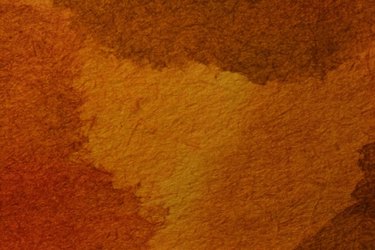
Watercolor paint can bring a unique look to an ordinary and lackluster wall. Applying watercolor paint on a wall can be a simple process; it requires a few basic tools to make it a success. Watercolors are perfect for walls because the transparent look provides a dual color with the original white wall as the base color. You have the option of using any color you desire to brighten your walls. There are also various techniques you can use to create a customized wall.
Colorwash
Video of the Day
Colorwash is the process of painting a wall with watercolors. Watercolors are thinner than your standard paint and it is usually used in paintings and other types of art. This style can give your walls and home a unique look. If you are a beginner, it may be best to purchase the colorwash kit at your local home goods or art and crafts store. This kit consists of a few watercolors to get you started, as well a cloth and protective gloves. Once applied, you get a transparent finish, which allows light to travel through the color. The sunlight will add richness and depth to your walls.
Video of the Day
Application of Watercolor on Wall
The process of mixing and applying the watercolor is quite simple. If your walls are flat without any gloss, you will need to mix half water and half watercolor paint. If you have semi-gloss on your walls, you will need to mix 25 percent percent water and 75 percent watercolor paint. You should mix the combination until the exact color is achieved. Put on the latex gloves that is supplied in the kit. You will then dip the cloth in the watercolor mixture and apply the cloth to the wall. Move the cloth in a circular motion and continue this process until the watercolor paint is completely on the wall. Allow the paint to dry overnight.
Stripes
Apply the base color on the wall as specified in section two and choose a color to use for your stripes. Mix your color for the stripes and use the cloth to apply the color in a downward motion. You can use painter's tape to make even stripes. The stripes on the wall will give smaller rooms a sense of depth and space. This technique will also brighten an ordinary room.
Patterns
For this process you will need to design a pattern. After the pattern has been designed, you will need to transfer that pattern onto acetate or oil board to create a stencil. You can purchase both acetate and oil board at your nearest arts and crafts store. Tape the stencil onto the wall in any location you desire and use the cloth to apply the watercolor paint to the stencil, creating the pattern on the wall.
Gingham
Measure the wall to determine where you would like to place the gingham design. Measure from the top down and mark every seven inches. Continue by measuring horizontally, from side to side. Place painter's tape from the top down, to make the vertical stripes. Apply watercolor paint in-between the tape. Allow the paint to dry overnight and continue the next set of horizontal stripes the next day. Place painter's tape horizontally and apply watercolor paint in-between the tape. There should be squares that are darker than others. Now there should be multiple stripes, vertically and horizontally.